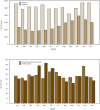Surveillance for Coccidioidomycosis - United States, 2011-2017
- PMID: 31538631
- PMCID: PMC6756189
- DOI: 10.15585/mmwr.ss6807a1
Surveillance for Coccidioidomycosis - United States, 2011-2017
Abstract
Problem/condition: Coccidioidomycosis (Valley fever) is an infection caused by the environmental fungus Coccidioides spp., which typically causes respiratory illness but also can lead to disseminated disease. This fungus typically lives in soils in warm, arid regions, including the southwestern United States.
Reporting period: 2011-2017.
Description of system: Coccidioidomycosis has been nationally notifiable since 1995 and is reportable in 26 states and the District of Columbia (DC), where laboratories and physicians notify local and state public health departments about possible coccidioidomycosis cases. Health department staff determine which cases qualify as confirmed cases according to the definition established by Council of State and Territorial Epidemiologists and voluntarily submit basic case information to CDC through the National Notifiable Diseases Surveillance System.
Results: During 2011-2017, a total of 95,371 coccidioidomycosis cases from 26 states and DC were reported to CDC. The number of cases decreased from 2011 (22,634 cases) to 2014 (8,232 cases) and subsequently increased to 14,364 cases in 2017; >95% of cases were reported from Arizona and California. Reported incidence in Arizona decreased from 261 per 100,000 persons in 2011 to 101 in 2017, whereas California incidence increased from 15.7 to 18.2, and other state incidence rates stayed relatively constant. Patient demographic characteristics were largely consistent with previous years, with an overall predominance among males and among adults aged >60 years in Arizona and adults aged 40-59 years in California.
Interpretation: Coccidioidomycosis remains an important national public health problem with a well-established geographic focus. The reasons for the changing trends in reported cases are unclear but might include environmental factors (e.g., temperature and precipitation), surveillance artifacts, land use changes, and changes in the population at risk for the infection.
Public health action: Health care providers should consider a diagnosis of coccidioidomycosis in patients who live or work in or have traveled to areas with known geographic risk for Coccidioides and be aware that those areas might be broader than previously recognized. Coccidioidomycosis surveillance provides important information about the epidemiology of the disease but is incomplete both in terms of geographic coverage and data availability. Expanding surveillance to additional states could help identify emerging areas that pose a risk for locally acquired infections. In Arizona and California, where most cases occur, collecting systematic enhanced data, such as more detailed patient characteristics and disease severity, could help clarify the reasons behind the recent changes in incidence and identify additional opportunities for focused prevention and educational efforts.
Conflict of interest statement
All authors have completed and submitted the International Committee of Medical Journal Editors form for disclosure of potential conflicts of interest. No potential conflicts of interest were disclosed.
Figures






Similar articles
-
Surveillance for Coccidioidomycosis, Histoplasmosis, and Blastomycosis - United States, 2019.MMWR Surveill Summ. 2022 Aug 19;71(7):1-14. doi: 10.15585/mmwr.ss7107a1. MMWR Surveill Summ. 2022. PMID: 36006889 Free PMC article.
-
Malaria Surveillance - United States, 2016.MMWR Surveill Summ. 2019 May 17;68(5):1-35. doi: 10.15585/mmwr.ss6805a1. MMWR Surveill Summ. 2019. PMID: 31099769
-
Malaria Surveillance - United States, 2017.MMWR Surveill Summ. 2021 Mar 19;70(2):1-35. doi: 10.15585/mmwr.ss7002a1. MMWR Surveill Summ. 2021. PMID: 33735166 Free PMC article.
-
Update on the Epidemiology of coccidioidomycosis in the United States.Med Mycol. 2019 Feb 1;57(Supplement_1):S30-S40. doi: 10.1093/mmy/myy095. Med Mycol. 2019. PMID: 30690599 Free PMC article. Review.
-
Public health surveillance for coccidioidomycosis in Arizona.Ann N Y Acad Sci. 2007 Sep;1111:96-102. doi: 10.1196/annals.1406.045. Epub 2007 May 18. Ann N Y Acad Sci. 2007. PMID: 17513465 Review.
Cited by
-
Valley Fever: Pathogenesis and Evolving Treatment Options.Cureus. 2023 Dec 10;15(12):e50260. doi: 10.7759/cureus.50260. eCollection 2023 Dec. Cureus. 2023. PMID: 38196429 Free PMC article. Review.
-
Valley Fever (Coccidioidomycosis) Awareness - California, 2016-2017.MMWR Morb Mortal Wkly Rep. 2020 Oct 23;69(42):1512-1516. doi: 10.15585/mmwr.mm6942a2. MMWR Morb Mortal Wkly Rep. 2020. PMID: 33090980 Free PMC article.
-
No Consistent Link Between Dust Storms and Valley Fever (Coccidioidomycosis).Geohealth. 2021 Dec 1;5(12):e2021GH000504. doi: 10.1029/2021GH000504. eCollection 2021 Dec. Geohealth. 2021. PMID: 34877441 Free PMC article.
-
Clinical Presentation of Blastomycosis is Associated With Infecting Species, Not Host Genotype.Clin Med Res. 2024 Mar;22(1):6-12. doi: 10.3121/cmr.2024.1880. Clin Med Res. 2024. PMID: 38609141 Free PMC article.
-
Proposed Relationships Between Climate, Biological Soil Crusts, Human Health, and in Arid Ecosystems.Geohealth. 2025 Jan 11;9(1):e2024GH001217. doi: 10.1029/2024GH001217. eCollection 2025 Jan. Geohealth. 2025. PMID: 39802983 Free PMC article. Review.
References
-
- Galgiani JN, Ampel NM, Blair JE, et al. Infectious Diseases Society of America (IDSA) clinical practice guideline for the treatment of coccidioidomycosis. Clin Infect Dis 2016;2016:27. - PubMed
MeSH terms
LinkOut - more resources
Full Text Sources
Other Literature Sources
Medical
Research Materials
Miscellaneous
